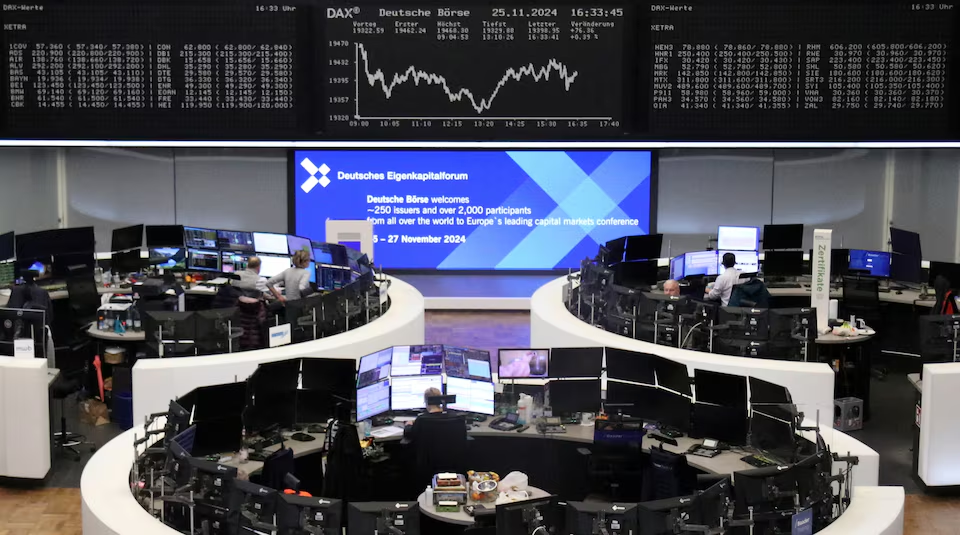European stocks and dollar perk up as markets slow for Thanksgiving

European Stocks See Modest Gains
European stocks have had a relatively positive week, with major indexes across the continent posting slight gains. The Stoxx 600, a broad index representing companies across 17 European countries, rose on the back of strong earnings results and positive sentiment in some key sectors, including energy and consumer goods. Market observers have pointed to a few factors contributing to this performance.
For one, the positive earnings reports from several large companies have provided a boost to investor sentiment. Firms in the energy sector, in particular, have benefited from rising oil prices, helping to offset broader economic concerns. Additionally, consumer goods companies have seen stable demand, reflecting resilience in European household spending despite inflationary pressures.
Investors also appear to be gaining confidence in the broader economic recovery in Europe. Economic data has shown some signs of stabilization in the region, particularly in Germany, Europe’s largest economy, which had been struggling earlier in the year. Manufacturing data has been improving, and there are indications that inflation is beginning to ease, creating a more favorable environment for stocks. However, growth remains sluggish in some areas, and many analysts remain cautious about the region’s long-term prospects.
The European Central Bank (ECB) has also played a role in shaping market sentiment. After a series of interest rate hikes aimed at curbing inflation, the ECB has signaled a more cautious approach going forward. With inflation pressures beginning to moderate, there is growing hope that the central bank may slow or pause its rate hikes, which would provide some relief to businesses and consumers alike. This dovish shift in the ECB’s stance has helped boost the overall outlook for European equities.
The Dollar Perks Up Amid Strong U.S. Data
In the U.S., the dollar has been on an upward trajectory, supported by stronger-than-expected economic data and the Federal Reserve’s policy stance. The greenback’s recent gains reflect investor expectations that the U.S. economy remains relatively resilient despite global headwinds, such as the ongoing challenges in China and Europe.
Recent U.S. economic reports have painted a picture of a robust economy, with GDP growth exceeding expectations and the labor market showing strength. Jobless claims remain low, and consumer spending has been relatively steady, bolstering the dollar’s appeal. These factors are reassuring investors that the U.S. economy can weather external pressures without a significant slowdown.
Another key factor influencing the dollar’s performance is the Federal Reserve’s monetary policy. The Fed has been steadfast in its approach to controlling inflation, with a focus on maintaining interest rates at higher levels until inflation is decisively under control. This has made U.S. assets attractive to global investors, driving demand for the dollar as they seek out better returns from U.S. bonds and other dollar-denominated assets.
Although the Fed has indicated that it might slow the pace of rate hikes in the future, its commitment to fighting inflation has continued to support the dollar, particularly in comparison to other major currencies like the euro, which has struggled with its economic challenges in the region.
Thanksgiving Slowdown in U.S. Markets
As the U.S. approaches the Thanksgiving holiday, trading volumes are expected to decrease. Historically, U.S. markets experience a slowdown during this time of year, with many investors taking time off to observe the holiday. This typically leads to lower liquidity in the markets, which can result in more volatile price movements. Despite this, there are still a few factors driving activity in the markets.
One of the key stories in U.S. markets remains the ongoing negotiations over fiscal policy and government spending. Lawmakers continue to debate key issues such as budgetary priorities, government funding, and the potential for a government shutdown in December. These discussions could create some uncertainty in the short term, particularly as investors weigh the potential impact of political gridlock in Washington on the U.S. economy.
The broader market sentiment remains relatively positive, however, with stock indices having posted strong gains throughout the year, even amid the various challenges the economy faces. The S&P 500, the Dow Jones Industrial Average, and the Nasdaq have all been buoyed by solid corporate earnings, particularly in sectors like technology, healthcare, and consumer staples.
Investors are also eyeing the upcoming holiday shopping season, with expectations of robust retail sales. Consumer sentiment remains high despite inflation, and many expect the holiday season to be a strong one for retailers, which could provide a further boost to the markets in the coming weeks. Retail stocks, in particular, have been among the beneficiaries of this optimism.
Global Outlook and Market Drivers
Looking beyond the U.S. and Europe, global market dynamics remain complex. Geopolitical tensions, particularly between the U.S. and China, continue to be a major source of uncertainty. The ongoing trade disputes, as well as concerns over China’s economic growth and its impact on global supply chains, are key risks that investors are watching closely. Additionally, Russia’s invasion of Ukraine and the associated sanctions have further complicated the global economic landscape.
Despite these challenges, the global economy has shown resilience, with many markets posting gains in 2024. Asian markets, particularly in Japan and South Korea, have been supported by a recovery in manufacturing activity and global demand for technology products. At the same time, emerging markets face their own set of challenges, including inflationary pressures and fluctuating commodity prices, which have added complexity to investment decisions.
As we head into the final month of the year, the outlook for European stocks and the dollar will depend on several key factors. In Europe, the outlook for economic growth remains uncertain, but the possibility of a slowdown in ECB rate hikes could provide support for equities. In the U.S., the Federal Reserve’s policy trajectory, along with consumer spending trends and political developments, will likely continue to shape the performance of the dollar.
For now, the Thanksgiving holiday may bring a temporary slowdown in U.S. markets, but the broader economic landscape remains a key driver of investor sentiment. European stocks, while benefiting from a more favorable economic environment, are still navigating challenges, including inflationary pressures and sluggish growth in some areas.
Ultimately, as 2024 winds down, markets will be closely watching for any signals of a shift in global economic conditions. While the U.S. dollar remains strong and European stocks show resilience, there are several risks that could alter the trajectory of both markets in the coming months. Investors will need to remain vigilant as they navigate the complexities of an interconnected global economy.






